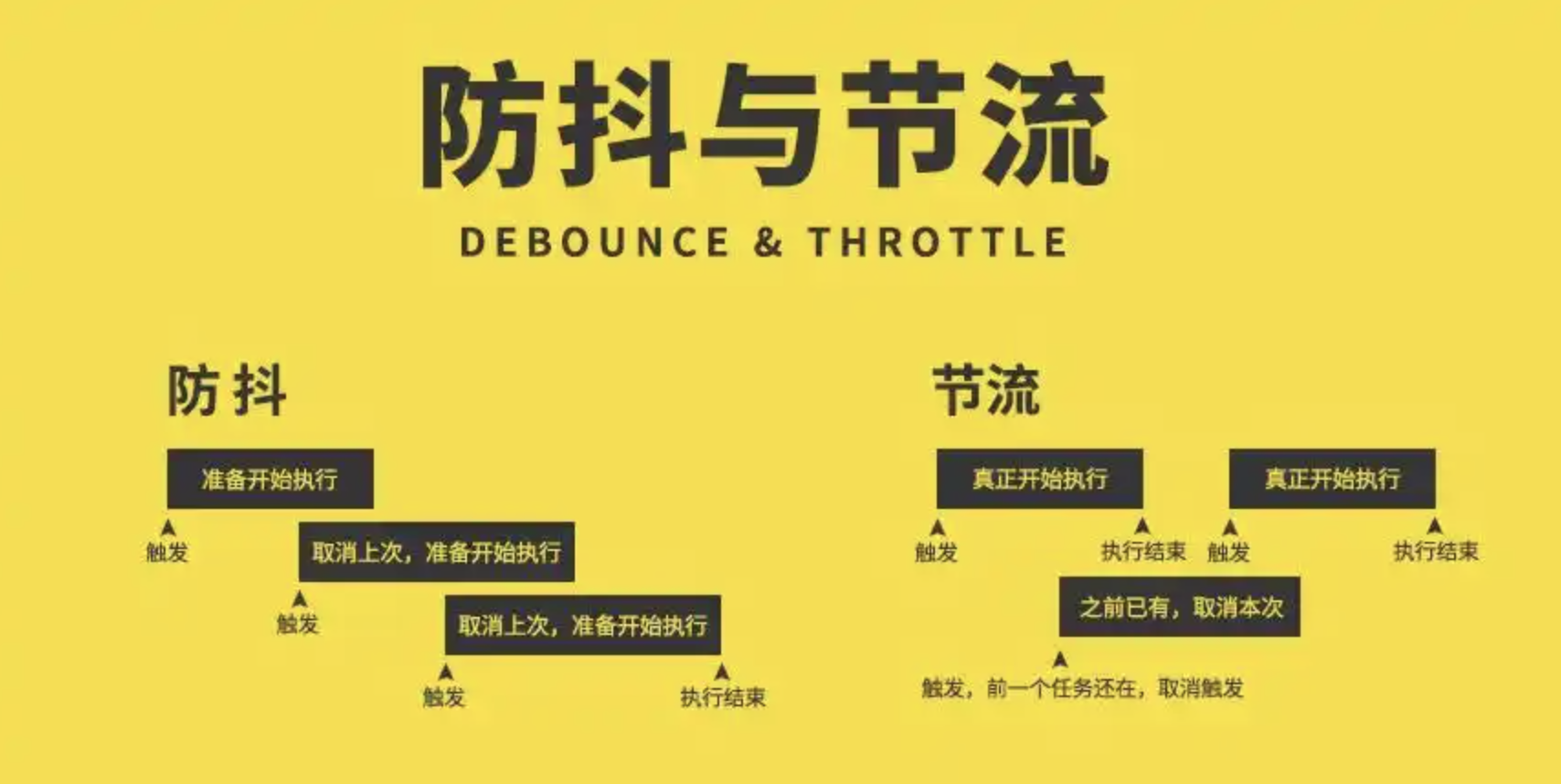JavaScript事件机制与性能优化:防抖 / 节流 / 事件委托 / Passive Event Listeners 全解析

目标:把“为什么慢、卡顿从哪来、该怎么写”一次说清。本文先讲事件传播与主线程瓶颈,再给出四件法宝(防抖、节流、事件委托、被动监听),最后用一套可复制的工具函数 + 清单收尾。
1)先理解“为什么会卡”:事件、传播与主线程
1.1 事件传播三阶段
捕获(capturing):从
window→document→ … → target,找目标元素。目标(at target):到达真正触发的元素。
冒泡(bubbling):从 target → … →
document→window反向冒泡。
常用属性:
el.addEventListener('click', handler, { capture: false }); // 冒泡阶段
// e.target:事件最初触发的元素
// e.currentTarget:当前正在运行回调的元素
// e.stopPropagation():阻止后续传播
// e.preventDefault():阻止默认行为(仅在事件可取消时)
1.2 UI 线程瓶颈(滚动与触摸最敏感)
滚动、触摸等事件是高频的:浏览器可能在一秒内触发几十到上百次回调。如果回调里:
改样式导致强制同步布局(layout thrashing);
做了重活(复杂计算、DOM 大量操作、同步 XHR);
或者阻塞滚动(在可取消的滚动相关事件里做了
preventDefault),
就会看到掉帧与卡顿。
核心策略:能少绑就少绑、能延后就延后(防抖/节流/rAF)、能复用就复用(委托)、能不阻塞就不阻塞(passive)。
2)防抖(debounce):过滤“高频抖动”,保留“最后一次/第一次”
场景:搜索输入联想、窗口尺寸变化、表单校验、复杂筛选。
思想:一段时间内多次触发→只在最后(或第一次)执行。
2.1 可直接用的防抖函数(含 leading / trailing / maxWait)
function debounce(fn, wait = 200, { leading = false, trailing = true, maxWait } = {}) {let timer = null, lastCall = 0, lastInvoke = 0, result;const invoke = (ctx, args) => {lastInvoke = Date.now();result = fn.apply(ctx, args);};const debounced = function (...args) {const now = Date.now();const ctx = this;if (!lastCall && leading && !timer) {invoke(ctx, args);}lastCall = now;const remaining = wait - (now - lastCall);const timeSinceLastInvoke = now - lastInvoke;const shouldInvokeMax = maxWait !== undefined && timeSinceLastInvoke >= maxWait;clearTimeout(timer);timer = setTimeout(() => {timer = null;if (trailing && (!leading || (now - lastInvoke >= wait))) {invoke(ctx, args);}}, remaining > 0 ? remaining : 0);if (shouldInvokeMax) {clearTimeout(timer);timer = null;invoke(ctx, args);}return result;};debounced.cancel = () => { clearTimeout(timer); timer = null; lastCall = 0; };debounced.flush = () => { if (timer) { clearTimeout(timer); timer = null; invoke(this, []); } };return debounced;
}
用法示例(输入搜索,尾触发):
const onQuery = debounce((q) => fetchList(q), 300);
searchInput.addEventListener('input', e => onQuery(e.target.value));
常见坑:
同时
leading与trailing为true时,注意一次“触发周期”内最多执行两次。防抖时间太长会造成感知延迟;交互型输入建议 200–300ms 左右。
3)节流(throttle):控制执行频率,平滑且可预测
场景:scroll / resize / mousemove / pointermove 等连续事件;滚动吸顶、进度计算、拖拽反馈。
思想:每隔固定间隔最多执行一次。
3.1 两种常见实现
时间戳法:更“实时”,首触发立即执行。
定时器法:更“平滑”,末尾补一次。
3.2 一个实战可用的节流(支持 leading/trailing/cancel/flush)
function throttle(fn, wait = 100, { leading = true, trailing = true } = {}) {let lastCall = 0, timer = null, lastArgs, lastThis;const invoke = () => {lastCall = Date.now();timer = null;fn.apply(lastThis, lastArgs);lastArgs = lastThis = null;};const throttled = function (...args) {const now = Date.now();lastArgs = args; lastThis = this;if (!lastCall && leading === false) lastCall = now;const remaining = wait - (now - lastCall);if (remaining <= 0 || remaining > wait) {if (timer) { clearTimeout(timer); timer = null; }invoke();} else if (!timer && trailing !== false) {timer = setTimeout(invoke, remaining);}};throttled.cancel = () => { clearTimeout(timer); timer = null; lastCall = 0; lastArgs = lastThis = null; };throttled.flush = () => { if (timer) { clearTimeout(timer); invoke(); } };return throttled;
}
3.3 rAF 节流(渲染节拍对齐,适合动画/滚动读写)
function rafThrottle(fn) {let ticking = false;return function (...args) {if (ticking) return;ticking = true;requestAnimationFrame(() => {fn.apply(this, args);ticking = false;});};
}
// 示例:滚动时读一次 scrollTop,写一次 transform(避免布局抖动)
window.addEventListener('scroll', rafThrottle(() => {const y = window.scrollY || document.documentElement.scrollTop;header.style.transform = `translateY(${Math.min(y, 80)}px)`;
}), { passive: true });
选择建议:
仅渲染相关 →
rafThrottle需要确定的时间频率 →
throttle仅在停止后处理 →
debounce
4)事件委托(Event Delegation):少绑监听,动态内容更省心
思想:把子元素的监听“上移”到父容器,在冒泡阶段一个回调搞定所有子项。
收益:
海量列表只绑一个事件处理器;
动态插入/删除子节点无需重绑;
更易做统一拦截/鉴权/打点。
4.1 一个可复用的 onDelegate 工具
function onDelegate(container, type, selector, handler, options) {const listener = (e) => {// 使用 closest 适配嵌套:匹配到最近的祖先const target = e.target.closest(selector);if (target && container.contains(target)) {handler.call(target, e, target); // this 指向匹配元素}};container.addEventListener(type, listener, options);return () => container.removeEventListener(type, listener, options); // 便于解绑
}
示例:列表点击/键盘交互
const off = onDelegate(document.querySelector('#todo'), 'click', 'button.remove', (e, btn) => {const li = btn.closest('li');li?.remove();
});// 动态新增 li 无需额外绑定
4.2 委托的注意点
不是所有事件都冒泡:
focus/blur不冒泡(可用focusin/focusout),mouseenter/leave不冒泡(用mouseover/out+relatedTarget)。e.stopPropagation()会截断冒泡,尽量在局部回调里少用或控制边界。Shadow DOM 下要理解 composed path,委托到 shadow root 外需要事件是
composed: true的。
5)Passive Event Listeners:不阻塞滚动的监听
在触发滚动相关事件(如 touchstart/touchmove/wheel)时,浏览器需要知道你的监听器会不会 preventDefault() 来阻止滚动。如果不确定,浏览器可能等待你的回调,从而产生卡顿。
被动监听(passive: true)告诉浏览器:我不会调用 preventDefault()。这样浏览器可以立刻滚动,显著改善滚动流畅度。
// 正确:滚动/触摸相关事件一般用 passive
window.addEventListener('scroll', onScroll, { passive: true });
window.addEventListener('touchmove', onTouchMove, { passive: true });
window.addEventListener('wheel', onWheel, { passive: true });
警告:被动监听里调用 e.preventDefault() 会被忽略(并可能在控制台收到提示)。
如果你必须阻止默认行为(例如自定义手势),就不要把这个监听设为 passive,或采用双通道策略(仅在需要时单独注册非被动监听)。
附:一次性、捕获阶段
el.addEventListener('click', onceHandler, { once: true });
el.addEventListener('click', capHandler, { capture: true });
6)组合拳:一个综合示例(滚动 + 搜索 + 列表)
<header id="header">Header</header>
<input id="search" placeholder="输入关键词..."/>
<ul id="list"></ul>
// 1) 滚动:rAF 节流 + passive
const header = document.getElementById('header');
window.addEventListener('scroll', rafThrottle(() => {const y = window.scrollY || document.documentElement.scrollTop;header.style.opacity = Math.max(0, 1 - y / 300);
}), { passive: true });// 2) 输入:防抖
const search = document.getElementById('search');
const query = debounce(async (kw) => {const data = await fetch(`/api/search?q=${encodeURIComponent(kw)}`).then(r => r.json());renderList(data);
}, 300);
search.addEventListener('input', e => query(e.target.value));// 3) 列表:事件委托(删除 & 点赞)
const list = document.getElementById('list');
function renderList(items = []) {list.innerHTML = items.map(it => `<li data-id="${it.id}"><span class="title">${it.title}</span><button class="like">👍 ${it.likes}</button><button class="remove">删除</button></li>`).join('');
}
const offRemove = onDelegate(list, 'click', 'button.remove', (e, btn) => {btn.closest('li')?.remove();
});
const offLike = onDelegate(list, 'click', 'button.like', (e, btn) => {const n = parseInt(btn.textContent.replace(/\D/g,'')) || 0;btn.textContent = `👍 ${n + 1}`;
});
7)性能与可维护性补充
读写分离:在同一个帧里,先读所有布局值,再写样式,避免反复读写导致强制回流。
减少监听数量:能委托就委托;不要给每个子项都绑监听。
用观测 API 替代轮询/滚动监听:
元素进入视口:
IntersectionObserver元素尺寸变化:
ResizeObserver
Pointer Events:用
pointer*合并鼠标与触摸逻辑,代码更少;配合getCoalescedEvents()获得更平滑的指针轨迹。易清理的监听:使用
AbortController一键解绑:const ac = new AbortController(); window.addEventListener('scroll', onScroll, { passive: true, signal: ac.signal }); // 需要时 ac.abort(); // 自动移除所有注册在该 signal 上的监听
8)不同事件的“推荐组合”速查
| 事件 | 建议 | 说明 |
|---|---|---|
scroll | passive: true + rafThrottle | 滚动读/写渲染属性时对齐帧率 |
touchstart/move | passive: true(若不阻止默认) | 需要自定义手势且要 preventDefault 时改为非 passive |
wheel | passive: true(不阻止默认) | 要自定义滚动逻辑时禁用 passive |
resize | throttle 100–200ms | 计算布局较多时适度加大间隔 |
input | debounce 200–300ms | 搜索联想等 |
mousemove | throttle 或 rafThrottle | 拖拽/绘图更推荐 rAF |
| 列表 item 点击 | 事件委托 | 动态增删子项最省心 |
focus/blur | 用 focusin/focusout 代替做委托 | 这两个才冒泡 |
9)常见坑与对策
在 passive 监听里调用
preventDefault
→ 无效且会有警告。确认是否真的需要阻止默认;需要时把该监听改为非 passive,仅作用于需要阻止的场景。委托 +
stopPropagation冲突
→ 下层组件阻断冒泡,会让上层委托失效。团队约定:组件层尽量少用stopPropagation,或在容器委托前移到捕获阶段。高频事件里读写混杂
→ 先读后写,或将写入放requestAnimationFrame,把读操作缓存到局部变量。误用
mouseenter/leave做委托
→ 它们不冒泡。改用mouseover/out+ 判断relatedTarget,或把监听直接绑到目标元素。匿名函数难以解绑
→ 封装返回off()的注册函数,或使用AbortController统一收束。
10)可复制的“最小工具集”
// 1) debounce(上文已给全量版,可直接复用)
// 2) throttle(上文已给全量版)
// 3) rAF 节流
function rafThrottle(fn) {let ticking = false;return function (...args) {if (ticking) return;ticking = true;requestAnimationFrame(() => { fn.apply(this, args); ticking = false; });};
}
// 4) 事件委托
function onDelegate(container, type, selector, handler, options) {const listener = (e) => {const target = e.target.closest(selector);if (target && container.contains(target)) handler.call(target, e, target);};container.addEventListener(type, listener, options);return () => container.removeEventListener(type, listener, options);
}
// 5) 安全注册(带 AbortController)
function on(el, type, handler, { passive, capture, once, signal } = {}) {el.addEventListener(type, handler, { passive, capture, once, signal });return () => el.removeEventListener(type, handler, { capture });
}
结语
先理解事件传播与主线程瓶颈,再对症下药:
高频 → 节流/防抖/rAF;
海量节点 → 事件委托;
滚动/触摸 → passive 默认化。
用一套可复用的工具函数和小清单,把“性能与流畅”变成默认选项,而不是事故后的补救。
